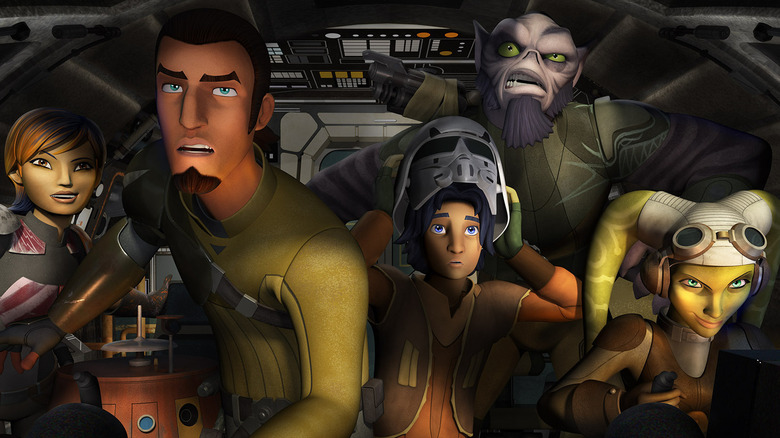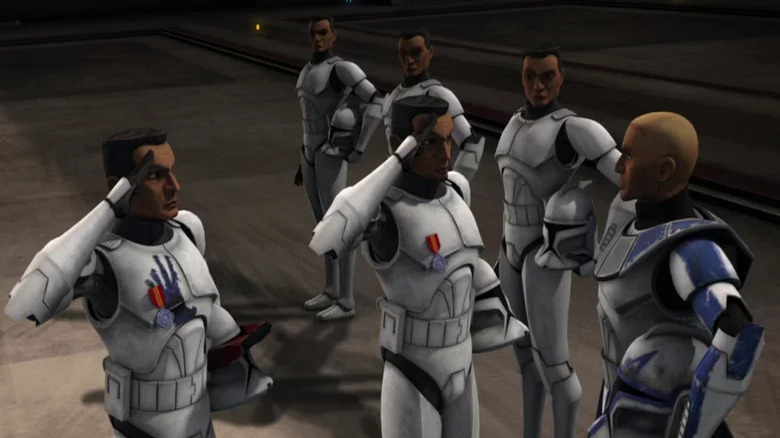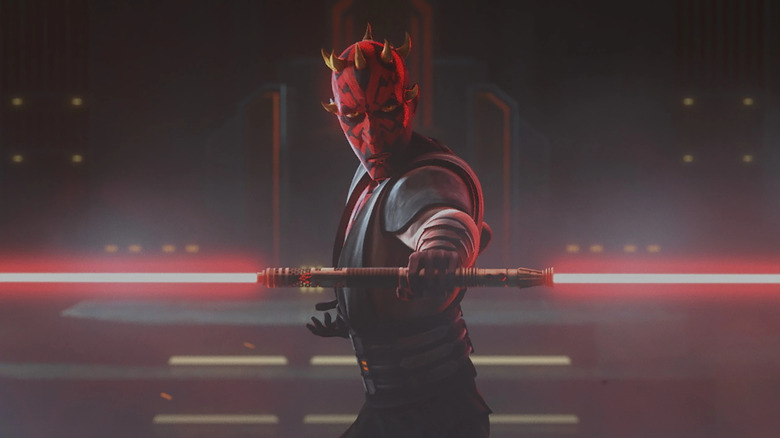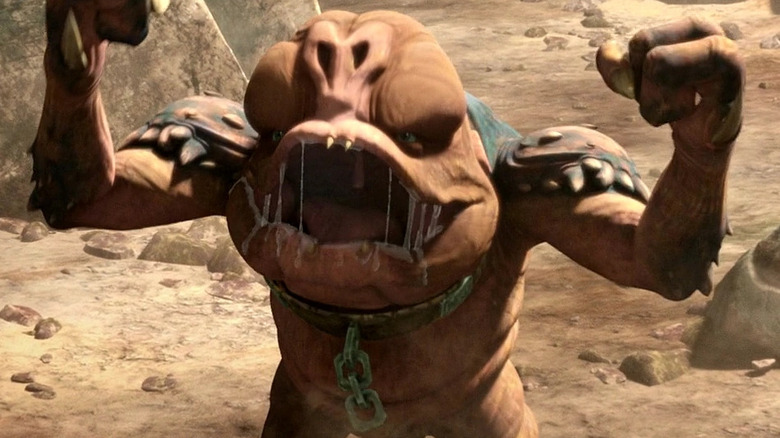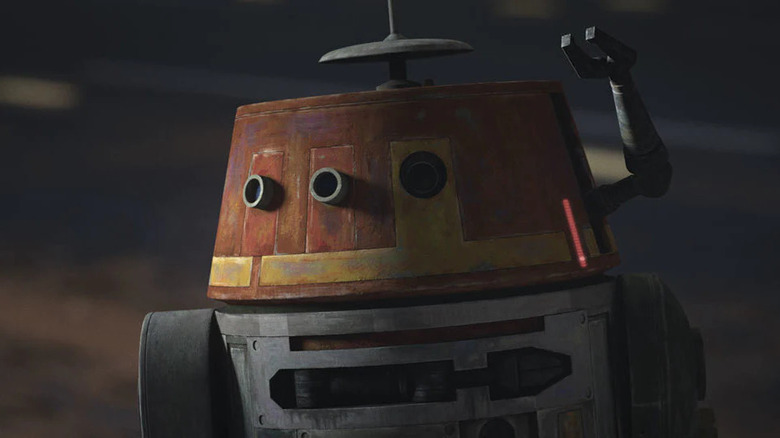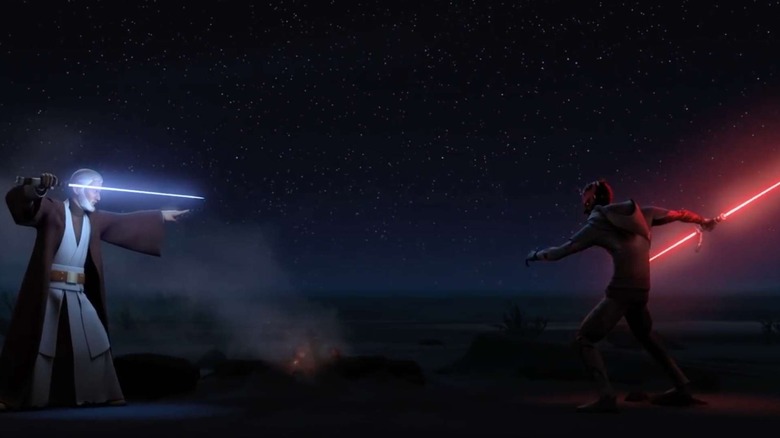Star Wars Rebels Co-Executive Producer Henry Gilroy Talks Working With George Lucas, Rancor Poop, Disney Notes And More [Exclusive Interview]
(Welcome to My Most Ridiculous Note, a series of interviews in which animators talk about the weirdest and funniest notes they received from studio executives.)
When "Star Wars: The Clone Wars" premiered, it helped revitalize the "Star Wars" franchise after the mixed reception of the prequels. It introduced the galaxy far, far away to a new generation, further developed the characters from the movies, made audiences fall in love with the clones, deepened the lore and mythology of the franchise, and so much more. Soon enough, it became as important a part of the "Star Wars" universe as any of the films.
From there we got "Star Wars: Rebels," a show that started out more kid-friendly than its predecessors, but quickly grew into becoming one of the most mature and complex "Star Wars" stories ever, one whose tone echoes in everything from "The Last Jedi" to "The Mandalorian" to "Andor."
While co-creators George Lucas and Dave Filoni need no introduction, there was another critical voice in the creation of "The Clone Wars" and in "Rebels" becoming the intense show it did — Henry Gilroy, who helped develop the former and joined the latter starting in season 2 as a co-executive producer.
In part one of our extensive talk with Henry Gilroy, we discussed his work on "Batman: The Animated Series" and how he even voiced the title character, a rather ridiculous note about Donald the Duck, and more. Now for part two, we head to a galaxy far, far away, with Gilroy telling us about getting notes from George Lucas, coming up with an explanation for Darth Maul's return, writing the final fight between Maul and Obi-Wan, and more.
'You guys are creating cinema'
"The Clone Wars" was a rather unique cartoon from the get-go, with multi-episode arcs that painted a picture of a tumultuous time in the galaxy and its key players, with stories that had consequences for the characters and the galaxy at large. We learned more about the clone troopers that defended (and then betrayed) the Republic, the Jedi who failed to see the rise of evil at their doorstep, and even the senators who tried and failed to stop the war before it escalated.
Having spent decades mostly working on creating the world of "Star Wars" by himself, "The Clone Wars" was the first time Lucas relied on others to significantly come up with new stories with his characters. Lucas was initially going to mostly just hand off the franchise to Gilroy and Filoni, telling them "I'm retired. I might see you guys once a year, twice a year maybe. You guys are making this. I'm not going to be around," according to Gilroy, who believes Lucas thought they were making a cartoon first, and "Star Wars" second. But instead, when he saw the first renders of the show, and how it had a cinematic 2.35:1 aspect ratio, he changed his mind. "Oh, you guys are creating cinema," Gilroy recounted Lucas saying, and from then on they met every week.
And this is another thing that made "The Clone Wars" unique, the way it incorporated live-action techniques in its animation, from camera work to lighting. By the time of the final season, "The Siege of Mandalore" arc delivered one of the best looking "Star Wars" stories ever, regardless of medium, with dynamic action, striking imagery and exquisite use of lighting that brings forth the emotion and excitement.
Bringing back Maul
In a cartoon full of surprises, one of the biggest ones, which came as a shock to the canon but quickly became very popular, was bringing Darth Maul back. Of course, that was a big gamble, considering that Maul had been very graphically cut in half in his first movie appearance. Making it worse was the fact that George Lucas spent years explicitly vowing never to bring Maul back, and using Maul's cut-in-half body as evidence.
But halfway through the run of "The Clone Wars," Lucas changed his mind, and he simply and vaguely instructed Dave Filoni and his team to figure out a way to bring the fallen Sith back to life. By that point, Gilroy had already left the show and the studio, but that didn't stop Filoni from contacting him one fateful night:
"He is like, 'Yeah, so yeah, George wants to bring back Maul.' I'm like, 'I knew he was going to do that. I knew it. I knew it.' Because, the reason why is, George likes to see the things that he created. And his ideas are awesome, so you can't argue with it."
To make things more complicated, they now had to find a way to bring back the character. While Filoni and his writers came up with a way to incorporate Maul into the show, Gilroy was tasked with writing a comic book story explaining how the former Sith survived getting sliced in half. "They only gave me eight pages, because literally it was like, 'We don't have time to do a full epic thing,'" Gilroy explained.
His solution was to have Maul literally survive by being fueled by hatred. "But then there was this toxic waste, he's kind of soaking in, and it cauterized his wounds, because it's so burning. And then he gets put in a garbage compactor and taken to the garbage planet. And George liked it. He's like, 'Oh, that's good.' So I'm like, 'Oh, all right.'
According to the animator, Lucas may have brought Maul back even earlier, if concept artists had their way. "George was considering that Grievous was Maul behind the armor plate," Gilroy said, referring to the cyborg Separatist General with an affinity for collecting lightsabers. "It made sense. He's cut in half and he's in this robot body or whatever. I'm glad that Grievous is his own thing anyway, but I thought it was interesting that the concept guys almost talked George into that."
Rancor poop
When it came to studio notes, "The Clone Wars" was as ideal a scenario as an animator could dream of, with George Lucas fighting to protect the staff from studio executives, no matter their department. As Gilroy tells it, Lucas assured them from the very beginning that they'd be making the cartoon the way they want, and if they have to cut anything for air, they'd just have the uncut version on the DVDs.
"Nobody's going to say no to George Lucas," Gilroy said. " It's awesome. He's like your plus-99 shield, any barbs just bounce off." Even marketing and licensing, which are a huge part of the "Star Wars" franchise, could not touch the animators. Early in Gilroy's time on the show, someone at licensing asked the staff if they could add something on a shot to justify the toys. "George basically called and said, 'Never contact them again.' So he forbid the toy people from ever contacting Dave and I, and his explanation to us was, 'You guys make great stories, let them make the toys after.'"
And yet, while the studio wasn't a big concern, they still had George Lucas himself giving notes, which is arguably way scarier. As Gilroy tells it, Lucas was very adamant about repeating himself (we do know he hated repeating himself so much he almost added hip-hop to "The Clone Wars"). So, when one of the scenes early on in the show was to be set at a Hutt palace, Gilroy had some ideas for the interior. "I put a Rancor, another Rancor monster, in the basement," the animator explained. "I'm like, 'Well, everybody, every Hutt has a monster in their basement.'" Lucas immediately called out that they had already done the Rancor in the basement, then threw his own funny suggestion.
"'I want to put below the Rancor, the Rancor has a grid, a screen, and then below it there are other creatures down there that eat the rancor poop.' And I'm like, 'What?' And he is like, 'Yeah.' And he says, 'We're going to call those Gilroys.' And I'm like, 'Oh, thanks George. Thanks a lot. Great.' So lucky, they never made that into a toy."
Lucas was very much against doing the same thing twice, even if, as Gilroy confesses, part of the fun of working on "Star Wars" is recreating the things you loved as a kid. Gilroy then named "The Force Awakens" and "Rise of Skywalker," and said "If I'd pitched those stories to George, he would've fired me. He would've just said, 'You're fired. I already did those.'"
'Oh, it's so Poochie'
Unsurprisingly, things changed once Lucas sold the studio and Disney started producing their own "Star Wars" cartoons. The first of these, "Star Wars Rebels," started out very differently from its predecessor, with a more kid-friendly tone and more humor. It was, as Gilroy describes it, a lite version of "The Clone Wars." At first, at least.
"At one point I had to send my responses to the Lucasfilm executive before they went to Disney," Gilroy explained. "I said my job at Lucasfilm is to protect the 'Star Wars' brand, not the Disney brand. And at the time, there was a difference of that and what they wanted that to be."
One example Gilroy recalls as particularly egregious was an image of the main character Ezra riding a droid named Chopper like it's a skateboard. "I hated that image from the beginning," Gilroy said, using a classic "Simpsons" reference to explain it. "It's so Poochie. It's extreme Ezra to the max. So I made a commitment to myself. I'm never going to have Ezra riding his droid like a skateboard. Droid's not a freaking skateboard."
As the co-executive producer tells it, the notes on "Rebels" were more of an issue of tone, of wanting to make the show lighter and fluffy when, as Gilroy tells it, "war is in the title of the show." Luckily, Disney realized that the show took a life of its own and had to mature along with the characters, so they stopped giving notes on the darker material — allowing for things like Maul slashing Kanan's eyes out.
"It was more like, 'Can you add a Chopper jet gag here?' We get notes like that," Gilroy explained, adding that it was mostly about softening emotion and fear. "I think whenever you talk down to kids though, they know that you're talking down to them. They don't like it."
Twin suns
"Star Wars Rebels" may have started out a bit heavier on the humor, and with a more episodic format, but it quickly became clear there was more to the show than first met the eye. Quickly, the cartoon started bringing in a darkness and complexity, with stories about rebellion that echoed those in "Andor," stunning and poetic action, and a deepening of the lore.
We got Force-sensitive creatures like the Bendu, time travel and more. The Force became even more of a mystical thing than in "The Clone Wars," echoing the original trilogy's approach to it. We see people of different races calling the Force by different names, reflecting their different beliefs.
One of the best episodes of the show encapsulates what makes "Rebels" so great: "Twin Suns." In it, Ezra is tricked into guiding Darth Maul to Obi-Wan, who has been hiding in Tatooine for years, with Maul finally about to enact his vengeance. The episode's climax is a fantastic fight between the two old rivals, ending with Maul's death — for real this time. It manages to both strengthen the stories that came before, while adding to the characters of this show, with Ezran finally, fully rejecting the dark side.
Gilroy co-wrote the episode with Dave Filoni, and the two came up with the idea of having Maul and Kenobi finally face each other one last time, but in a vastly different way than we've seen before. That's because, as Gilroy said, "we saw these guys at their peak in Clone Wars' when they were fast and sharp. And now they're these older guys and they're just not... It's not going to be the same thing." So the fight is rather quick, thought out, planned, more meticulous, "most of the fighting is being done in their head before they actually ever fight."
In the end, Gilroy helped both bring Maul back, and finish his story, but he is humble when talking about it. "I don't think about my part in it so much," the animator said. "I'm glad that people are touched by this and like it."
When looking back at the making of "Rebels," and how it went from a show a lot of fans criticized for being too different from "The Clone Wars," to a show that didn't need to tie into anything else, Gilroy reflected on how the show ended on its own terms and with a final episode that's longer than normal. "They were like, 'Oh right. You guys have created something really special here. People love these characters and they're going to be in the TV series. Live action series.' So that part is really rewarding."
